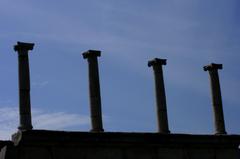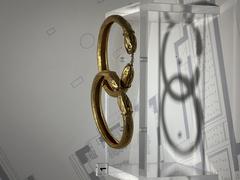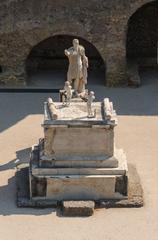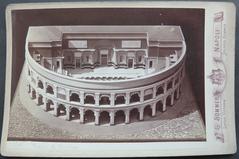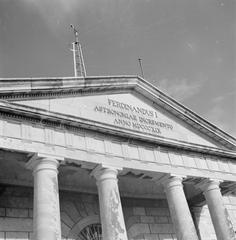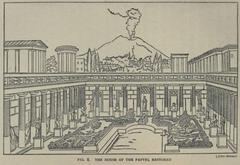
Thermae Centrali Herculaneum: Visiting Hours, Tickets, and Comprehensive Travel Guide
Date: 04/07/2025
Introduction
Nestled at the foot of Mount Vesuvius on the Bay of Naples, Herculaneum offers a vivid glimpse into Roman life, none more so than through its remarkable Thermae Centrali (Central Baths). These baths are among the most exquisite and best-preserved examples of Roman public bathing culture, showcasing advanced engineering, intricate mosaics, stucco work, and rare preserved wooden elements. The site’s extraordinary state of preservation is due to the catastrophic eruption of 79 CE, which paradoxically allowed organic materials and fine details to survive for millennia.
This guide provides everything you need for a memorable visit: a historical overview, architectural highlights, visiting hours, ticket information, accessibility tips, and recommendations for nearby attractions. Whether you are a history enthusiast or a curious traveler, this article ensures you are fully prepared to explore one of Italy’s premier archaeological treasures (herculaneumtickets.com; Rome Art Lover; planetware.com).
Table of Contents
- Discover Herculaneum: A Must-Visit Naples Historical Site
- Origins and Early Development of Herculaneum
- Urban Layout, Social Life, and the Thermae Centrali
- The Eruption of 79 CE and Herculaneum’s Preservation
- Rediscovery, Excavation, and Conservation Efforts
- Visiting Herculaneum: Hours, Tickets, and Tips
- Thermae Centrali: History, Architecture, and Visitor Experience
- Nearby Attractions and Exploring Naples
- Frequently Asked Questions (FAQ)
- Conclusion & Key Visitor Tips
- Sources and Official Links
Discover Herculaneum: A Must-Visit Naples Historical Site
Herculaneum is a remarkably well-preserved Roman city, offering visitors a unique opportunity to explore ancient streets, luxurious villas, and public spaces. The Thermae Centrali stand out as a highlight, representing the sophistication and communal spirit of Roman society. The combination of archaeological richness, accessibility, and proximity to Naples makes Herculaneum an essential stop for travelers in southern Italy.
Origins and Early Development of Herculaneum
Founded in the 6th century BCE, possibly by Hercules according to legend, Herculaneum grew from Oscan and Samnite roots into a Roman seaside retreat for the wealthy (herculaneumtickets.com; historyskills.com). By the 1st century BCE, the city boasted elegant villas, advanced infrastructure, and a vibrant urban life centered around its forum and public buildings (tripates.com).
Urban Layout, Social Life, and the Thermae Centrali
The city featured carefully planned streets and neighborhoods for both elite and working-class residents. Public amenities like the Thermae Centrali were key social hubs, providing not only bathing facilities but also spaces for exercise, relaxation, and business. The baths, built close to the forum, included separate areas for men and women, each with apodyteria (changing rooms), tepidaria (warm rooms), and calidaria (hot rooms), all powered by advanced hypocaust systems (tripates.com).
The Eruption of 79 CE and Herculaneum’s Preservation
The eruption of Mount Vesuvius in 79 CE buried Herculaneum beneath up to 30 meters of volcanic material. Unlike Pompeii, Herculaneum was engulfed by pyroclastic surges, carbonizing organic materials and preserving them in extraordinary detail (herculaneumtickets.com). This unique preservation offers an unparalleled insight into Roman architecture, daily life, and material culture.
Rediscovery, Excavation, and Conservation Efforts
Rediscovered in 1709 and systematically excavated since 1738, Herculaneum has been the focus of ongoing archaeological and conservation projects. The Herculaneum Conservation Project, initiated in 2001, continues to protect and study the site, ensuring it remains accessible for future generations (romecabs.com; tripanthropologist.com).
Visiting Herculaneum: Hours, Tickets, and Tips
Visiting Hours:
- April 1 – October 31: 08:30 – 19:30
- November 1 – March 31: 08:30 – 17:00
- Closed: January 1 and December 25
(Always check the official website for updates.)
Tickets:
- Adults: €11–€13
- Concessions: ~€5.50
- Free entry for minors under 18 and on the first Sunday of each month (expect larger crowds)
- Combined tickets for Pompeii and other sites are available (headout.com).
Guided Tours & Audio Guides:
Guided tours with archaeologists and audio guides (including via the Audiala app) are highly recommended for deeper insight.
Accessibility:
Some areas are wheelchair accessible, but ancient surfaces can be uneven. Contact site staff for accessible routes.
Travel Tips:
Wear comfortable shoes, bring water and sun protection, and arrive early to avoid crowds. Photography is allowed without flash.
Thermae Centrali: History, Architecture, and Visitor Experience
Historical Significance
Constructed during the 1st century BCE and expanded over subsequent decades, the Thermae Centrali were supplied by an aqueduct introduced during Augustus’ reign. Their central location near the Decumanus Maximus ensured easy public access (Rome Art Lover).
Architectural Layout
The baths are divided into separate male and female sections. Men’s areas are larger and more lavishly decorated; both include a sequence of rooms for the full Roman bathing ritual:
- Apodyterium (Changing Room): Features niches and preserved wooden shelves.
- Frigidarium (Cold Room): The men’s version displays a dolphin mosaic and a domed ceiling.
- Tepidarium (Warm Room): Notable for geometric patterned mosaics.
- Calidarium (Hot Room): Equipped with a hypocaust system, marble benches, and stuccoed walls (Herculaneum.uk).
Engineering Marvels
The baths demonstrate Roman mastery of water management and heating. Water was supplied via lead pipes from the Naples aqueduct. The hypocaust system circulated hot air beneath floors and within walls, regulating temperatures and providing comfort (Rome Art Lover).
Artistic Highlights
Mosaics in the apodyterium and tepidarium depict marine and geometric motifs. Stucco vaults, marble benches, and painted surfaces evoke the luxury of ancient Roman public spaces (Herculaneum.uk).
Visitor Experience
The Thermae Centrali offer an immersive experience with informative signage, optional guided tours, and audio guides. The well-preserved interiors allow visitors to appreciate both the grand architecture and small, personal details of Roman daily life (lucatourguide.eu; planetware.com).
Nearby Attractions and Exploring Naples
After exploring the Thermae Centrali, consider visiting:
- Pompeii: A larger, world-famous Roman city.
- Mount Vesuvius: Hiking trails with panoramic views.
- Naples: Museums, lively streets, and classic Neapolitan cuisine.
- Other Herculaneum sites: Villa of the Papyri, House of the Wooden Partition, Suburban Baths.
Local amenities in Ercolano include cafes, restrooms, and souvenir shops.
Frequently Asked Questions (FAQ)
Q: What are the visiting hours for the Thermae Centrali?
A: Vary seasonally; typically 08:30–19:30 (summer) or 08:30–17:00 (winter). Last entry is one hour before closing.
Q: How can I purchase tickets?
A: Online via official/authorized vendors or at the entrance. Advance booking recommended, especially in high season.
Q: Is the site accessible for people with mobility issues?
A: Partially accessible; contact staff for assistance.
Q: Are guided tours available?
A: Yes, both in-person and audio guides (including via Audiala) are available.
Q: Can I take photos inside the Thermae Centrali?
A: Yes, but flash and tripods are generally restricted.
Q: How long does a typical visit take?
A: Allocate 30–45 minutes for the baths, and 2–3 hours for the whole site.
Conclusion & Key Visitor Tips
The Thermae Centrali offer a rich and evocative window into ancient Roman society, art, and engineering. Their preservation—from mosaics and stucco to rare wooden elements—makes them a must-see for any visitor to Herculaneum or Naples. For the best experience:
- Visit early or late in the day.
- Wear comfortable shoes.
- Use guided tours or the Audiala app for deeper insight.
- Respect preservation rules and enjoy this extraordinary journey into the past.
Whether as a standalone destination or as part of a broader exploration of Campania’s archaeological wonders, the Thermae Centrali remain a highlight of Italy’s cultural heritage (herculaneumtickets.com; headout.com; lucatourguide.eu).
Sources and Official Links
- herculaneumtickets.com
- Rome Art Lover
- headout.com
- lucatourguide.eu
- pompeiisites.org
- planetware.com
- whatsdownthatstreet.com
- Herculaneum.uk


